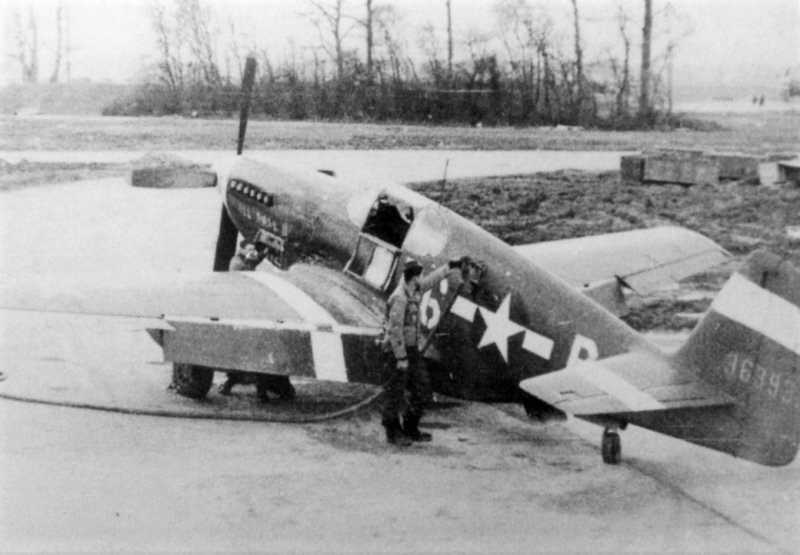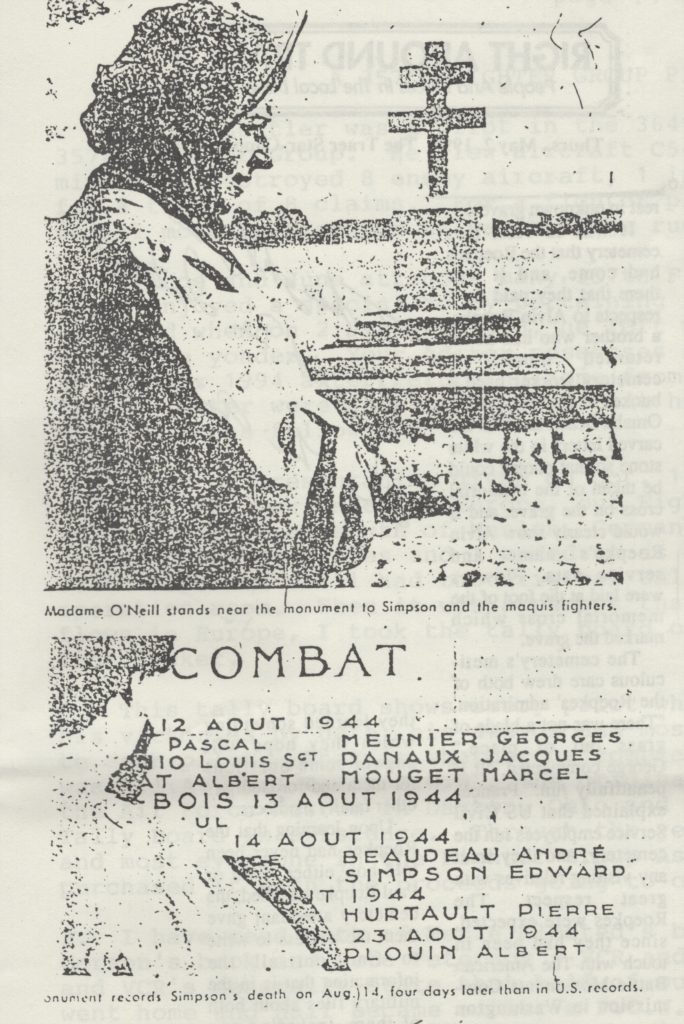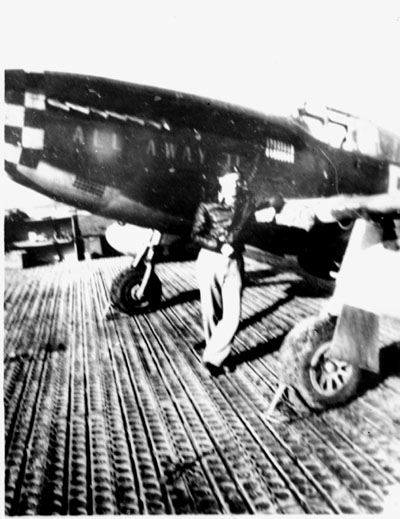
Captain Simpson’s first P-51B “All Away II” 43-6393 B6-P, Named after a horse.
The ‘Dead’ Yank Hero of Orleans Forest
The Stars and Stripes 25 Nov 1959 By Paul Kackley
A World War II fighter pilot, listed as killed in action on Aug. 10, 1944, actually died four days later with the Maquis.
A row of nine simple wooden crosses, deep in the heart of the Forest of Orleans in France, marks the spot where an American fighter pilot enjoyed his last moment of peace on earth.
Just as the crosses were being driven into the ground, a series of shots shattered the dawn quiet of the forest.
Minutes later, Capt. Edward K. Simpson was dead. But he died a hero – sacrificing his life that a group of freedom fighters he had known only a few days might live.
This was Aug. 14, 1944, the day remembered by the people of this part of France as the “day that the Maquis were attacked.”
Members of the maquis who were in the forest that day remember that Simpson joined them late in the evening of Aug. 10, after his fighter plane was shot down south of the Loire River and several miles from the Maquis’ forest hiding place.
Just after landing, Simpson was contacted by two of the freedom fighters who were returning from carrying messages to Col. Marc O’Neill, commander of the maquis in four districts of France, who was then near Orleans.
“Our couriers led him back through the German lines to our hiding place,” recalls Madame O’Neill, widow of the former maquis commander. “They thought he was British, since the only other English-speaking persons they had met during the war were a few British agents who worked with us.”
At the time Simpson joined the marquis, the Allied forces had pushed to within a few miles of Orleans, and the German troops in the area were showing signs of a retreat to the north. The Free French fighters who had been operating from the Orleans forest for several months were awaiting orders to break out of the woods and join other Maquis units in the push to Paris.
Rather than run the risk of trying to slip Simpson back to American forces, the marquis leaders suggested to him that he remain with them until time for the whole unit to break through the German Panzer division surrounding the forest.
The funeral service Simpson was attending when the attack began was for nine members of the Maquis who had been killed in a fire-fight on the outskirts of the forest. (The bodies of the nine were moved after the war, but the crosses marking the graves are still there.)
Although several of the freedom fighters fell when the patrol opened fire, the well-armed group quickly overpowered the Germans and drove them off. But knowing that their hiding place had been discovered, the Free French – numbering between 200 and 300 – decided the time had come to escape from the woods and join the Allied forces near Orleans.
Hurriedly breaking camp they had occupied for several months – signs of which can still be seen – the hunted men rushed through the woods to their well hidden motor pool nearly a mile away. Most of their vehicles were captured from the Germans.
Simpson found a place on the last truck of the convoy as it broke from cover and raced down one of the forest’s narrow trails leading to the Orleans highway.
As the Maquis vehicles turned on to the highway, they were spotted by a German column of trucks and armored cars. The Germans pursued the maquis convoy and were rapidly closing in, when, Simpson made a decision – and died.
Knowing that the German column had to be stopped, one of the Frenchmen riding in the truck with Simpson called for the driver to slow down, and reached for a heavy machine gun.
As the truck slowed, Simpson and five of the Frenchmen dropped from it and set up the machine gun in the center of the road as the truck roared away. All six of the men surely realized that they could not escape death, since the point where they established their roadblock was flat and completely without protective cover.
The final action those men fought was brief, but successful. Their first burst of machine-gun fire stopped the lead German vehicle and blocked the road. They kept firing until all six were dead.
But the time they gained was enough, for by the time the road was cleared, the Maquis convoy was well on the way to Orleans and out of reach of the Germans.
“I was with my husband when the convoy reached us,” Madame O’Neill recalls. “When he asked for a report of the action all we heard of for nearly 15 minutes was as account of the bravery of six men – especially the English-speaking one.”
She continued, “Our soldiers were so impressed with the fact that Simpson gave his life for them even though he didn’t have to, and didn’t even know those he died with.”
Simpson’s actions impressed the people of Ouzouer-sur-Loire – a village just a few yards from where he died – so much that they collected enough money to build a small monument at the scene of the road block. Many of the villagers were members of the marquis during the war.
The monument lists the names of the six men killed there.
Simpson’s name also appears on a large monument dedicated to all of the Maquis. This second memorial located on a circle in the center of the forest, is inscribed with the names of those who lost their lives during the bitter fighting in the wood in August 1944.
Near the monument to the Maquis O’Neill’s tomb. He was killed in Algeria in 1956. The French government granted his wish to be buried in Orleans forest in gratitude for his leadership of the Maquis.
Ironically, while the French people haven’t forgotten the actions of the brave young American pilot, it is possible that no one – including – his own family – from his own country even knew how he died.
“I told the first Americans I met about Simpson,” Madame O’Neill recalls. “But they were combat troops busy fighting, and I’ve wondered ever since if the manner of his death was ever entered in his official record.”
Marc Grippon, who operates a café in Ouzouer-sur-Loire, and who buried Simpson’s body in the local cemetery, also tried to tell Americans how Simpson died.
“When the graves registration soldiers came here to move his body, I tried to tell them about Simpson,” Grippon said. “But I don’t speak English and they didn’t speak French, so I’m sure they didn’t understand me.
Evidently his words were not understood, for Simpson’s official record of service, on file at the U.S. Army Reports Center in St. Louis, states he was killed in action in France on Aug. 10, 1944 – four days before he actually died.

The following is from Mr. Merle Olmsted (357th FG Association Historian):
The final paper work on this affair is dated 15 years later, in 1960! Under date of 31 March, 1960, the Casualty Section of the Adjutant General’s office wrote to Chief, Personnel Services Branch. It relates the above facts, and adds that the 25 November, 1959 issue of Stars and Stripes newspaper had a detailed article about the action in which Simpson died, titled “The Dead Yank of Orleans Forest.”
Upon learning of these clippings, the Army Records Center at St. Louis, sent them on to the Casualty Branch for investigation, which in turn, passed them along to the Commanding General, U.S. Army Communications Zone, Europe, asking for sworn statements from witnesses to the event.
Although two persons were found with knowledge of the event, neither had actually witnessed it. The letter concludes: “It is not possible to obtain an eye-witness account of Capt. Simpson’s death. However, in view of official information contained in AG 201 file (burial report and report from intelligence officer and record at Mairie ) there is no doubt that Captain Simpson was killed in action on 14 August, 1944. Although every detail of the circumstances attending Capt. Simpson’s cannot be verified by an eye-witness statement, the information is confirmed, in part, by the official records and there is no reason to question the authenticity of the information contained in the newspaper article. It is recommended that a report of death be issued showing that Captain Edward K. Simpson was killed in action on 14 August, 1944 in ground combat with German forces while fighting with French Maquis.”
Captain Edward K. Simpson is buried in the American cemetery at Epinal in France.
Captain Eddie Simpson honored on French Memorials

Eddie with “All Away II” P-51B, 43-6393, B6-P

